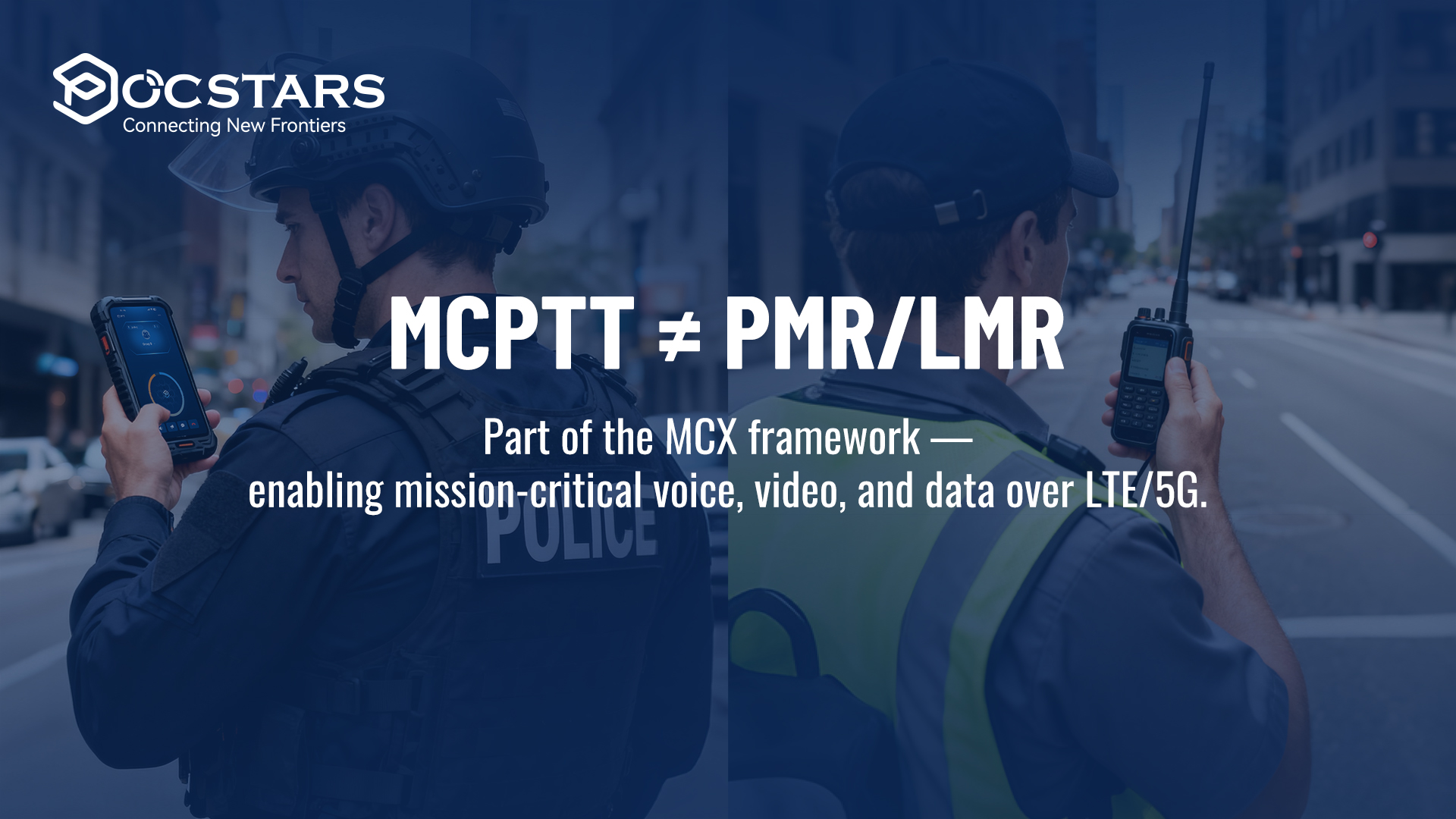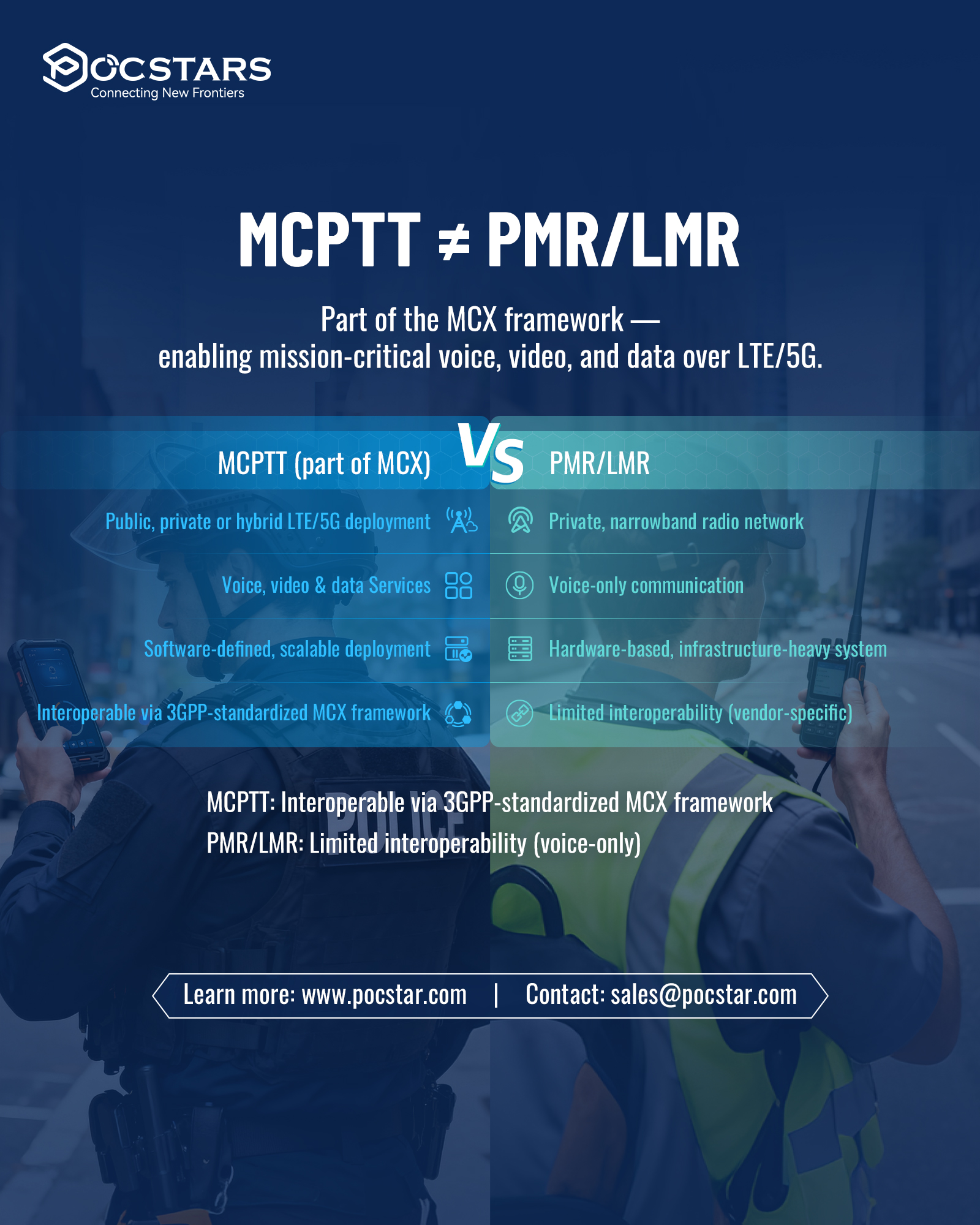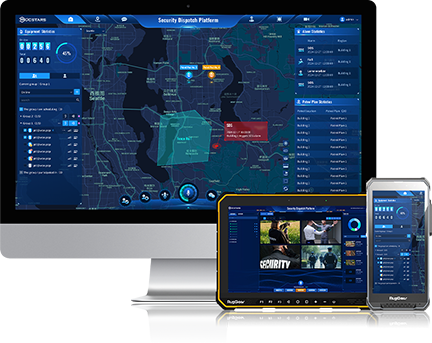MCPTT ≠ PMR/LMR: Understanding the Evolution of Mission-Critical Communications

As organizations transition from narrowband radio to broadband networks, one question often arises:
Is MCPTT meant to replace PMR/LMR?
The short answer is no — it builds upon it.
Both technologies serve the mission-critical community, yet they were designed for different eras and infrastructures. Understanding their differences helps agencies and enterprises plan a safer, smoother migration toward broadband operations.
From Narrowband to Broadband
For decades, PMR (Professional Mobile Radio) and LMR (Land Mobile Radio) have been the foundation of public safety and emergency response communications.
They deliver instant, reliable voice over private, dedicated narrowband networks — exceptionally robust for voice, but limited in terms of data and interoperability.
MCPTT (Mission Critical Push-to-Talk), on the other hand, is part of the broader MCX framework (MCPTT, MCVideo, MCData) defined by 3GPP.
It brings mission-critical communication into the LTE/5G era, enabling not just voice, but also video, data, and real-time situational awareness — all within one interoperable broadband platform.
Key Differences Between MCPTT and PMR/LMR

1. Network: LTE/5G Integration vs Private Narrowband
MCPTT (MCX) operates on LTE/5G core networks—whether public, private, or hybrid. It leverages carrier-grade capabilities such as QoS, network slicing, and policy control to maintain low latency and reliable performance over wide areas.
PMR/LMR, in contrast, depends on dedicated narrowband radio networks. These offer unmatched local voice reliability, but require costly frequency coordination and engineering work to achieve multi-agency connectivity.
In short: MCPTT delivers wide-area flexibility through modern integration; PMR/LMR ensures localized dependability through isolation.
2. Services: Voice + Video + Data vs Voice Only
MCPTT (MCX) expands traditional Push-to-Talk into multimedia collaboration—integrating live video, mission data, location tracking, and IoT telemetry. It enables visual command and data sharing in real time, all within a single session.
PMR/LMR remains optimized for voice-first communication. Although some systems support limited data via gateways, they are fundamentally designed for fast and reliable voice.
In short: MCX turns “mission communication” into “mission coordination.” PMR/LMR remains unrivaled for instant voice reliability.
3. Architecture: Software-Defined & Scalable vs Hardware-Centric
MCPTT (MCX) follows a software-defined architecture, where core components—application servers, policy control, and media resources—can be virtualized or containerized for cloud or on-premise deployment. This enables elastic scaling, redundancy, and smooth updates with minimal downtime.
PMR/LMR relies on hardware-based infrastructure—base stations, repeaters, and dedicated controllers. Expanding capacity or introducing new functionality often requires new physical installations, which increases cost and time-to-deploy.
In short: MCX evolves through software; PMR/LMR grows through engineering.
4. Deployment Model: Public, Private, or Hybrid
MCPTT can run on public mobile networks, dedicated LTE/5G private networks, or a hybrid of both.
This flexibility allows fast rollout for enterprises or large-scale coverage for government users, balancing CAPEX and OPEX according to mission needs.
PMR/LMR typically operates on private, dedicated radio networks, providing strong control and reliability, but limited scalability and reach.
In short: MCX enables flexible, scenario-based deployment; PMR/LMR provides fixed, purpose-built assurance.
5. Interoperability: Multi-Layer vs Voice-Only
Both technologies offer interoperability—but at very different depths.
PMR/LMR systems can achieve voice interoperability both across vendors within the same standard (e.g., DMR, TETRA, or P25) and across different standards via gateways or middleware platforms. However, such interoperability typically remains limited to voice communication.
MCPTT (MCX), defined under 3GPP standards, extends interoperability to voice, video, and data—enabling cross-network, cross-vendor, and cross-agency collaboration.
In short: PMR/LMR connects talk groups; MCX connects ecosystems.
6. QoS, Priority & Preemption (QPP)
MCPTT integrates Quality of Service (QoS), Priority, and Preemption controls at the LTE/5G core level. This ensures that emergency calls and high-priority users always gain network access—even under congestion.
PMR/LMR provides similar control within a single radio domain, but not across multiple networks.
In short: MCX delivers end-to-end priority; PMR/LMR maintains system-level control.
7. Security & Compliance
MCPTT (MCX) incorporates end-to-end encryption, SIM-based authentication, TLS/IPSec, and SRTP, aligning with modern IT and cloud security frameworks for auditing and compliance.
PMR/LMR uses frequency-based and air-interface encryption, ensuring secure voice channels, but with limited integration into broader IT ecosystems.
In short: MCX bridges communication with IT security; PMR/LMR secures communication within its radio domain.
Transition Path: Coexistence, Not Replacement
The shift toward broadband is not a sudden leap—it’s an evolution.
Most organizations adopt a hybrid model, maintaining PMR/LMR for mission-critical voice while introducing MCPTT (MCX) for multimedia communication and extended coverage.
Through standardized Interworking Functions (IWF), both systems can coexist, ensuring continuity during the migration phase.
In short: MCPTT doesn’t replace PMR — it expands what’s possible.
From Narrowband Radio to Mission-Critical Broadband
The future of mission-critical communication lies in convergence, not competition.
As industries embrace digital transformation, MCPTT—within the 3GPP-defined MCX framework—bridges radio-grade reliability with broadband intelligence, enabling a new era of connected safety and operational efficiency.
Learn More
Discover how POCSTARS delivers both PoC and MCX solutions—supporting organizations across business-critical operations and mission-critical communications.
Learn more: www.pocstar.com
Business inquiries: sales@pocstar.com













